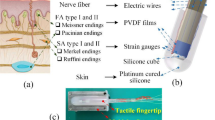Abstract
Tactile sensing has become crucial in robotic applications such as teleoperation, as it gives information about the object properties that cannot be perceived by other senses. In fact, it is essential that robots are equipped with advanced touch sensing in order to be aware of their surroundings and give a feedback to an operator. Such sensing systems are made of sensors and an elaboration unit that acquires tactile signals and process the data, retrieving information such as texture, hardness, and shape. In this paper, we propose a novel tactile sensing system made of flexible, high sensitive and high spatial resolution piezoelectric polyvinylidene fluoride‐trifluoroethylene P(VDF-TrFE) sensors, and a low power and low cost Interface Electronics (IE) that can acquire data from 32 channels simultaneously with a sampling frequency of 2KSamples/s. We validate the system acquiring data from three different objects to classify their hardness using an artificial neural network of one hidden layer with approximately 89% accuracy. The signal processing and the classifier will be hosted by the IE in the next future.
Access this chapter
Tax calculation will be finalised at checkout
Purchases are for personal use only
Similar content being viewed by others
References
Shahbazi, M., et al.: A systematic review of multilateral teleoperation systems. IEEE Trans. Haptics 11(3), 338–356 (2018)
Haddadin, S., et al.: Robot collisions: a survey on detection, isolation, and identification. IEEE Trans. Robot. 33(6), 1292–1312 (2017)
Fishel, J.A., Loeb, G.E.: Sensing tactile microvibrations with the BioTac comparison with human sensitivity. In: Proceedings of the IEEE RAS and EMBS International Conference on Biomedical Robotics and Biomechatronics, pp. 1122–1127. IEEE, Rome, Italy (2012)
Ibrahim, A., et al.: Near sensors computation based on embedded machine learning for electronic skin. Procedia Manuf. 52, 295–300 (2020)
Luo, S., et al.: Robotic tactile perception of object properties: a review. Mechatronics 48, 54–67 (2017)
Bandyopadhyaya, I., et al.: Tactile sensing based softness classification using machine learning. In: Souvenir of the 2014 IEEE International Advance Computing Conference, pp. 1231–1236. IEEE, Gurgaon, India (2014)
Boutry, C.M., et al.: A hierarchically patterned, bioinspired e-skin able to detect the direction of applied pressure for robotics. Sci. Robot. 3(24) (2018)
Zhang, Z., et al.: Hardness recognition of fruits and vegetables based on tactile array information of manipulator. Comput. Electron. Agric. 181, 105959 (2021)
Drimus, A., et al.: Classification of rigid and deformable objects using a novel tactile sensor. In: IEEE 15th International Conference on Advanced Robotics New Boundaries Robot, pp. 427–434. IEEE, Tallinn, Estonia (2011)
Fares, H., et al.: Validation of screen-printed electronic skin based on piezoelectric polymer sensors. Sensors 20(4), 1160 (2020)
Saleh, M., et al.: Experimental assessment of the interface electronic system for PVDF-based piezoelectric tactile sensors. Sensors 20(19), 1–12 (2019)
Hardware Specifications. https://sdk.rethinkrobotics.com/wiki/Hardware_Specifications#Maximum_Joint_Speeds. Accessed 18 May 2021
Acknowledgment
The authors acknowledge partial financial support from TACTIle feedback enriched virtual interaction through virtual reality and beyond (TACTILITY) project: EU H2020, Topic ICT-25-2018-2020, RIA, Proposal ID 856718. The authors acknowledge the support of Prof. Fulvio Mastrogiovanni and Dr. Hossein Karami, DIBRIS, University of Genova, for making available the Baxter robot.
Author information
Authors and Affiliations
Corresponding author
Editor information
Editors and Affiliations
Rights and permissions
Copyright information
© 2023 The Author(s), under exclusive license to Springer Nature Switzerland AG
About this paper
Cite this paper
Amin, Y., Gianoglio, C., Valle, M. (2023). A Novel Tactile Sensing System for Robotic Tactile Perception of Object Properties. In: Di Francia, G., Di Natale, C. (eds) Sensors and Microsystems. AISEM 2021. Lecture Notes in Electrical Engineering, vol 918. Springer, Cham. https://doi.org/10.1007/978-3-031-08136-1_28
Download citation
DOI: https://doi.org/10.1007/978-3-031-08136-1_28
Published:
Publisher Name: Springer, Cham
Print ISBN: 978-3-031-08135-4
Online ISBN: 978-3-031-08136-1
eBook Packages: EngineeringEngineering (R0)




